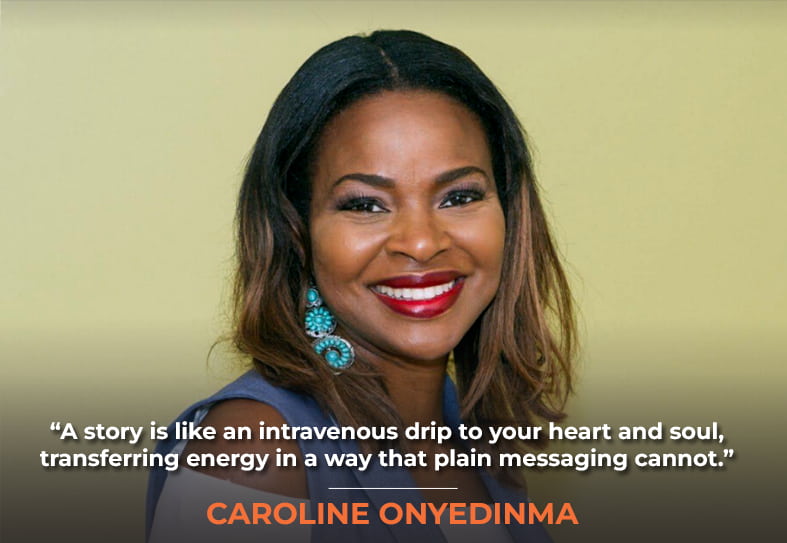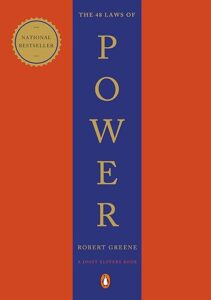Stories shape not just how we communicate, but how we connect and convert in business. My guest on today’s show, Caroline Onyedinma, is a master storytelling strategist and former software engineer who helps entrepreneurs turn their content into revenue. With nearly two decades of experience translating complex technical concepts for Fortune 500 boardrooms, Caroline now teaches coaches and consultants how to harness the power of authentic storytelling.
In our conversation, Caroline explains how to turn simple daily experiences into compelling stories. She shares practical ways to maintain authenticity while using AI and introduces frameworks that consistently drive results. Her “48 Laws of Story” methodology shows exactly how to build a story bank that attracts premium clients. Through real examples from her own journey and her clients’ successes, she demonstrates what makes stories truly convert. She reveals how “deluxe lurkers” – high-ticket buyers who silently consume content – can become engaged clients through strategic storytelling.
Learn how to turn your social media posts into daily sales opportunities and discover why human storytelling is becoming even more crucial in an AI-dominated world. And now, without any further ado, on with the show!

In This Episode
- [02:46] Caroline Onyedinma shares how her storytelling prowess translated complex tech concepts for Fortune 500 boardrooms, showcasing the power of clear and engaging narratives.
- [08:33] Caroline reveals what makes a story meaningful and not.
- [12:43] Uncover the critical distinction between meaningful stories and purposeless messaging that lacks direction and efficacy.
- [14:13] Caroline uses a personal story about her son’s diet to illustrate turning everyday moments into business insights.
- [22:03] Caroline details how she enhances storytelling using AI without losing the essential human touch in content creation.
- [24:48] Caroline introduces the 48 Laws of Story framework, offering a glimpse into how it consistently generates engaging content that draws premium clients.
- [33:24] Caroline explains why storytelling is the ultimate daily sales tool, bypassing the need for webinars and launches and creating constant cash flow.
- [38:46] With AI’s rise, Caroline emphasizes the irreplaceable value of human storytelling and challenges listeners to maintain their unique identity in content.
- [42:46] Discover how Caroline’s program helps you stay ready with a “story bank,” ensuring you’re perfectly positioned when opportunity strikes.
Caroline, it’s so great to have you on the show.
Thank you. Excited to be here.
Yeah. We know each other through the Joint Venture Mastermind (JVMM), Dov Gordon‘s mastermind. He’s been a guest on this show and of great folks in that group, and we got to meet through that amazing, illustrious group. So it’s good to have you here today.
Thank you for having me.
So, let’s talk about storytelling and why you focused on that so strongly in your business, career, and life purpose.
Sure. I’ve always been a storyteller before I knew about storytelling. It’s just something that is part of my personality. I feel that it brings you on your life journey. I really like to connect with people. So, storytelling was just a great way of doing that. And I remember people used to say to me, “You’re such a great storyteller.”
Storytelling is a great way of connecting with people, and it’s something that’s been a part of my personality even before I realized its power.
I didn’t really understand what that meant at that time. My background is that I was a software engineer for nearly 20 years. I went to one of the best schools for technology in the world. So I thought I was destined to be behind a desktop with other nerds designing systems and talking geek speak. But what happened is, sure, I was a great developer; I was hands-on, and we were designing systems. But often, in the corporations that I worked in, Fortune 500 corporations, the board, the CEOs, the subject matter experts, and the stakeholders were not technical, and they couldn’t really understand what we were doing in the lab.
And so what happened is I could use stories to break down very technical, high-level concepts in a way that everybody could understand. From then on, I was asked to always come into the boardroom when they had these conversations to translate, right? So, I was the linchpin between the business and the tech and the marketing and the sales because I would break down these stories and simplify them in ways because who knows what TCP/IP is or the network layer.
So, I would break these things down. Or how Java bytecode works. I would break these things down so that the CEO didn’t look crazy and that he could go to his town hall meetings and explain to the stakeholders and shareholders what we were doing and our direction in a very simple and easy-to-understand way. I found myself being taken out of development more into the business, into customer-facing roles to interface with our vendors and different people and breaking down things so much easier with story. I knew I was onto a thing, and I carried that on when I came into the business and built my own business through content organically, which was powered by storytelling.
You have courses, you have programs. Actually, the one that I purchased was sold with stories. So I’m a customer, a client of yours. What makes your programs different from the other courses and programs out there that talk about storytelling and how to sell through storytelling? What’s different?
Okay, so as a storytelling strategist, there are different areas, such as customer journeys, in which we can tell stories. So, like here, I just told you a story. I’m on a podcast. You can tell stories for podcasts, and you can tell stories on the stage. TEDx speakers tell stories. So there are so many different points as a messaging strategist, right? Because storytelling is a type of messaging. But what I found is that when we show up every day on social media, there’s a certain art and science to telling stories on social media. Posts that drive leads, engagement leads, and sales straight off your social media posts, straight off the newsfeed, without having to do launches or webinars. All right, and so this is how I was helping my clients to make high ticket sales or any sales every single day, using the power of their stories.
And I really emphasize that it doesn’t have to be big blockbuster movie stories because most of us do the same thing every day. We’re not really living this glamorous social media life that a lot of people like to portray. So I teach them how to take any moment, whether it’s a marvelous moment or a mundane moment, and turn that into an insightful, impactful storytelling post that not only shows the five top things, I want them to show your vision, who the villain is in the story mean and the pain points of your audience, what the vehicle of transformation is for your offer, what your point of view is.
We’re really doing those storytelling angles or those messaging angles to examine every part of you, not just your offer but who you are and your essence, to build a bond with your audience. But we’re also doing this so that we drive a click closer to a high ticket sales conversion. So whether the story now drives them to a DM, a sales page, or whatever mechanism you choose to sell, that’s what we’re doing.
And so, every day, if you shoot your shot on social media and tell meaningful stories that connect to the next step in your process of getting someone to pay you money, you’re going to get sales. And this is very different from a lot of people who are just waiting till they do a five-day challenge or a webinar, which takes time.
Storytelling can turn mundane moments into powerful messages, connecting your audience to the core values of your business.
I was like, well if you tell a story a day, you’re going to get sales. Something’s going to come in. And even if it’s not sales, it’s sales-related activity, engagement, conversations, a bigger audience trust, all of these things and a way to express yourself very authentically in business so that your audience knows the real you. So, that’s why I love storytelling. It’s the secret weapon of every coach and consultant who wants to sell every day without launches or webinars. It’s not to say that they don’t do launches and webinars. It’s just that we can’t launch or do webinars every single day, but you can tell a story every day.
So, what makes a story meaningful versus not meaningful?
I always say that sometimes there’s a difference between a story that sells and a fortuneless fable. A fortuneless fable is a narrative with no purpose, meaning, or North Star to the story. It’s just something random that you have put out there. Many people do that in their content, but it has no end goal or purpose. Meanwhile, storytelling must have a purpose, and we must decide what that purpose is before we even craft the story. So, the story must have an insight that it wants to share. It must be collected from some kind of solution or principle that you have or that is the foundation of your offer. And then it should have a way to bring somebody closer to not just your offer but somebody being introspective, asking them some questions.
It should have a way of shifting identity. So the idea is that we are presenting your ideas. We are creating our identity shift. Before somebody buys your offer, they buy your identity and shift their identity so that they can embrace your offer or the ideas that your offer is based on. This allows us to create demand for our offers, especially high-ticket offers. Right? It’s not every day somebody’s going to give you five figures without understanding who you are, why you’re different, why they should trust you, why what you are selling or your ideas are different from what they’ve tried before and what they failed with.
So, this is the difference between just plain messaging and storytelling. You’re using some kind of wisdom or somebody else’s event scenario, a circumstance to pull a truth or a perspective or idea from it, which is really connected to why you do things the way you do in your business or why you see things differently and why that viewpoint has led you to choose this vehicle of transformation which leads them to your offer.
A story must have a purpose, insight, and a way to shift identity to connect your audience to your offer.
So that’s the difference. When I see somebody just messaging and somebody storytelling, I can tell if someone’s put a piece of content out there just to put a piece of content out there. And I can tell if somebody’s really thought out what the North Star of this message is and has an insight, lesson, or moral connected to a story that will bring sales home. And sometimes, it’s not just about sales. Sometimes you just want to. And when I say sales, it’s all activity connected to sales. So trust, rapport, and engagement conversations are things that lead to a cell down the line.
What would be an example, North Star, of a message and a story that maybe one of your clients has put out there? And that’s been quite effective.
So, really, I asked them what they were comfortable with sharing. So, usually, what we do is start because when people come to me, I don’t have any stories. I don’t have anything fun to share. So, I really ask people to focus on their values first because we want four things. We want values, we want vision. We want to hear it in their vibe and voice. When somebody comes to me, they start with a blank slate. They don’t have anything interesting to share.
They don’t have any stories. And what I say to them is that everything is a story. Let’s talk about taking inventory of the most mundane things or the everyday things that you have done in the world in the last two weeks. What usually happens is that they think the story has to be connected to their offer. And that’s the big mistake. The story is not connected to your offer. We have a segue, which is a seamless transition that can make any story relatable to your offer. So, we just focus on the story.
So, for instance, I would look around and ask them, what did you do in the last two weeks? What was fun? What was not so fun? What experiences do you have? Who did you talk to? So sometimes, they pull out things their clients are going through, and that’s fine. That’s a way to tell. But sometimes, I just want them to tell me, especially if it’s giving their audience an insight into who they are. What was dear to your heart? This week, I’ll give an example of something I did recently. And this translates to how I pull stories out of my audience. I took my son to his first business conference two weeks ago. Now, it was just an event. I didn’t think much of it.

And then I said, “why did you do this?” And I looked at my why in this. And even though he’s at college, I really want him to get an early taste of what entrepreneurship is and what it means to have the heart and hunger to build something for yourself apart from what his parents are able to give him. And I looked at why that was so important to me and why.
How is that connected to how I help people? Well, the very reason that I am in entrepreneurship, storytelling, helping people, and structuring their messaging is that I really want them to have autonomy. I really want them to show up and make a difference. I really want them to be able to take an idea and bring it to implementation to change the work. That’s their superpower, entrepreneurship. So, I could see where there was a common theme between the two.
So, I wrote a great storytelling post about that. But I didn’t start with storytelling about the event because the event was the insight. I spoke about my son’s diet when he was a kid. So, my daughter and I raised her really sugary desserts when she was a baby. Cause I had a sweet tooth, and I thought that was amazing. But my son, I learned my lesson when he was born. And I raised him on this organic cereal called Weetabix, which had no sugar in it and was very healthy. And to me, it tasted like cardboard.
Storytelling allows us to create demand for high-ticket offers by sharing perspectives, wisdom and connections to people’s identities.
But the idea I brought about was whetting their appetite for healthy, nutritious food to help them grow strong. I’d made a mistake with my daughter, but with my son, I had learned my lesson. And then I said, “‘Well, what has that got to do with business?” Well, now I’m whetting my son’s appetite for a business or a way of life that will make him strong and healthy. He’s not going to have him dependent on others. That sugar kind of dependency and addiction where everybody else gives you wealth, right? But you don’t know how to get wealth, and you don’t know how to build yourself up. So I know it was a silly story about my son’s eating habits when I was younger, but it really resonated with people because it was deep. And then I segued to. That’s why I took him to his first business conference to whet his appetite for wealth at an early age.
Just the way that I had to change their palette from being dependent on the sugar of wealth, right? People are handing them stuff down, right? A trust fund is already made for them because 90% of people will squander their parent’s trust fund. Do you see what I mean by the time? And that’s the statistics. So it really resonated with people. But do you see? I took a mundane event and thought about why it was dear to me. Then I went to look for a basic story from their childhood where I could kind of connect with them like Legos and then bring people to why my offer is so important because it empowers them in that way as well.
Why am I whetting everybody’s appetite for wealth? Why am I helping you to build your platform with your own stories rather than running to other people and being dependent on them to feed you with sugary desserts that don’t give you the foundation you need to build a strong, healthy business for yourself? So, do you see that storytelling can be anything? If you’ve got a little bit of imagination, if you’ve got some wisdom, if you’ve got some insights that are important to you. And when we put all these building blocks together, it’s almost like Lego. You get a beautiful construction afterward, which becomes key storytelling pieces that bring the right people home to your business.
And so that’s what I do with people. I help them find very mundane things that they can’t see as a story, and I help them orchestrate them into social media masterpieces that speak to people at a level that most people are not speaking.
Every story that you tell is absolutely powerful and is the secret source that will drive sales in your business more than anything else that you do. Share on XYou do it effortlessly and well and incorporate that into your business and life. I just want to read off an email you sent to me where you used your incredible storytelling to put me back into a moment when you reconnected with me via email after some months of us not being in communication. So let me read this to you. You might remember it.
“Hey, Stephan, it’s been a while, but I don’t know if you remember the breakout session on JVMM. When I first met you, you gave me your backstory and narrated how you asked God to give you an assignment. I was thinking, I know times are hard, but you’re the world’s best SEO expert. Surely, you don’t want to go back to the cubicle. ‘Oh, so you wanted God to find you a new job?’ The other coach on the call looked at me crazily and said, ‘No, he’s talking about a spiritual assignment.’ Oh, the secondhand embarrassment. At the end of the call, you were kind enough to give us each an invite to be guests on your SEO and spiritual podcasts. Guess which link I got. I just thought I’d narrate that story because, as you could tell, I didn’t get out much. (A little tongue-in-cheek emoji there.) If the offer is still open to come on your SEO podcast, I’d love to attend.”
That’s an example of you using the methodology and expertise you teach in an everyday reconnection email. And, of course, here you are in the podcast.
The difference between just messaging and storytelling is the insight that drives a deeper connection and a potential transformation for your audience.
There I am. It works because, you know, everybody has a certain personality that needs to be showcased. That’s what we connect with. Somebody’s essence, their aura, their vibe. That was a funny story. It was quite an interesting story because I learned a lot from it. Then I went to go and understand more about what that meant and why I had this duh moment. But then it was a great way to be vulnerable and connect back with you in case you’d forgotten me, to show the impact that you made on me and to share that what is life if you can’t share humorous or funny or awkward moments with people and laugh over it to build a better bond as humans.
And I feel that when we do that in our content, whether we’re storytelling, in emails, on social media, on podcasts, on YouTube, wherever we decide that we want to meet our audience in the middle, we should bring our essence, we should bring our human side. And a lot of people don’t do this on social media or within their business. And it makes them very distant. So it’s all about authenticity, which is so important in the age of AI because a lot of people, and I’m all for using AI in your business to create content, but they’re doing it in a way that strips the uniqueness of you from you. Storytelling is a foolproof way to make sure that even if you are using AI, you are still keeping authenticity, which is what makes the content convert. Because nobody has your story, nobody has your vibe, nobody has your thoughts. Right?. AI wouldn’t have been able to tell that story.
AI would never have come up with a story like the one you replayed for me in that email.
Exactly. There wouldn’t be a connection. AI could create a story, but it couldn’t create a story with the energy because of our experience. That’s why I’m all for AI, but we use it as an assistant and an accelerant rather than an author. Because AI helps us amplify our authenticity rather than replace it. So storytelling, even though, you know, some people are like, well, I want to, you can go artisan, you can go AI but with your content. Right? However, storytelling is always going to be authentic just because you have to bring your unique perspectives and experiences to the content.
And that’s what people are really connecting to because nobody’s trying to show up for and bond with the bot.
Much to Mark Zuckerberg‘s disappointment.

Yes, exactly. Once we know it’s the bot, and it’s not you thinking, feeling, and emoting like that, it’s almost anti-climax. So sure, the bot is supposed to help you communicate your thoughts, ideas, and perspective. But it should really be coming from the heart of how you feel and experiences that you’ve had or the experiences that your clients have had. So this is why I try to put some storytelling elements in everything I do, even if it’s a couple of lines. And that’s the best way for people to really say what they mean in their messaging because a lot of people are just virtue signaling. They’re really not bringing their unique perspective, and this is what makes them stand out. This is really their USP when it comes to business. This is their secret weapon, and they should most definitely utilize it.
Yeah. So, how do you incorporate AI with all its amazing capabilities and not lose the soul, the essence, and the heart in the output that you get from AI? How do you accelerate, as you say, using AI but not lose the juice?
Well, here’s the thing. When AI first came out two years ago, I had this dilemma because I had my program sold with stories. And it was an amazing program. Step-by-step storytelling instructions were very detailed, which was not a script but was structured and allowed people to tell their own stories connected to a common thing. And it was very successful. People were actually telling stories. They were getting engagement, they were getting conversation, they were getting leads. But after a while, they would stop writing the stories.
You can have AI assist you in content creation, but it can’t replace your authenticity.
It was not because the structures weren’t amazing; it was just bandwidth. You know, people who are solopreneurs or doing everything in their business have a certain amount of time. But I still wanted to; I love the uniqueness of their stories because 10 people could use the same story structure I’d given them, and the story would feel totally different. You couldn’t even recognize it. So when AI came out, I didn’t want to lose that edge; I didn’t want to lose that uniqueness. But as a software architect developer for nearly two decades, I knew it wasn’t the time to be a tech luddite.
Okay. I mean, I had been using AI before it was widely known and spread. And I was like, “Oh, we’ve arrived in marketing now.” So, I decided that I had to take a stance. But I knew that people were really scared of having soulless, empty content, which was very easy to ignore. So, the whole purpose of putting out content is for you to stand out and shine. But the more AI content out there, the more it gets ignored. I was scrolling past.
I didn’t want to be the AI police, but it had a vibe about it where I could tell they didn’t really care. They were just putting out content for the sake of content. So I sat down, and I started to build prompts and really go back and reverse engineer what I had done in my story structures to build it into custom GPTs that would do a lot of the heavy lifting for them without removing their responsibility to put their vision, voice, vibe values, their real thought process into their content. So, how do I use this as an assistant? It is almost like Grammarly, which helps you structure your stuff better or catch the language without moving your essence.
I came up with this framework called The 48 Laws of Story, based on the The 48 Laws of Power, which I use to interview people to get their perspective on foundational or universal truths, which I teach them how to build into stories connected to their vision, vibes, values and then how that is connected to their offer or what they sell or what they believe in creating this pre-selling experience where every story you read is a footstep step on the journey of you and bring somebody closer to a major conversion.
So at the point they get to message saturation, they’re going to be like, “you know what? I think this is the person I don’t need to get on a webinar. I’ve read 20 of these. Okay, I didn’t feel like I was reading. I’m actually binge-consuming.” I call these people deluxe alert because high ticket buyers who don’t make themselves known to you but binge consume you should be somebody’s daily fix. You should be challenging people. They shouldn’t always agree with stuff. And I know it works because I have a lot of seven and eight-figure secret followers.
But at one point, I’ll post a story, and they can’t help but put their two cents in, and then I’ll see them in my comments. Right? This is great because it shows me its work and allows us to have an authentic conversation in the DMs I would never have had previously because I didn’t know where they were. They don’t usually like to announce that they’re following you because they have a certain status and positioning. But we now have authentic rapport.

So storytelling helps to do this because now what it helps is it accelerates your content creation, and it helps you get your ideas out there faster with my process of extracting your stories and then showing you. I have a framework called Story Sway, which is the CTA of structuring the story and content that tells a story. Sway stands for the section where the audience yields. And that’s where the insight comes in. This is the reason I’m telling you. This story is present, and this is where we do the persuasion; this is where we do the sleight of mouth. All these different techniques I’m using are not just to say this is my opinion, but to change somebody like we were debating. So, like Marcus Aurelius. Okay, right. Really breaking something down.
Then, the CTA is where we position our offer and send them to a CTA, whether it’s a call to buy, reflect, converse, call to whatever that is, or whatever the next action step is that you want them to take. Now, we can do this handcrafted artisan, but it’s slower. And what we need for visibility if we’re doing organic traffic is velocity; we need speed. Right? So, this is what the AI component helps us to do. They still have the same ideas and originality, but we accelerate it with AI to have more content out on a newsfeed.
Quality over quantity. But you need to show up more because it’s a consistency issue for people selling organically. If you consistently have quality content out there and have 5,000 people on your social profile, you have quality content two to three times a week. You have a five-figure offer; it doesn’t have to be five-figure, but if you’re selling high tickets and it’s your signature program, the fraction of the fraction is going to give you six-figure, typically ROI in a year.
It’s just the right eyes on the right content at the right time, and you’re going to have sales combustion. And that’s how it works. And people started to see that if it’s not a sale, it’s the things that lead to a sale. A conversation engagement around your profile leads people to ask you to come on podcasts like this or to speak about other opportunities that can lead to a sale. But once you’re visible in that way and with great value, value is how to create and think about content.
You don't get ready; you stay ready so that when somebody discovers you, there's enough to binge consume. Share on XAnd not just how to think content, but how you think content, right? That’s what’s going to get people to say, I think this is the person I’ve been looking for. And then when they see your high ticket program, it’s not an issue of how much; it’s how I can give this to her quickly because this is exactly what I need. Because they understand how your offer works, all without doing webinars, which is great. Not that I’m against webinars or launches, but you can’t do one every day.
So, this 48 Laws of Story, is that a program, a course, a book, or just a term that you use?
Well, it’s a term I use for a framework in my program called High Ticket Messaging Mastery. There are two ways to do what the program does. You can do it one-on-one with me or in mini-groups. So, it’s a hybrid program. So, first of all, I help you nail your messaging because before you run to AI or content, you must understand what your core message is, what your why is, what your U.S. peers, you know, those typical marketing things that we run away from. But without that clarity, it’s going to be hard to create any cohesive content out there.
And then I go through the 48 Laws of Story to pull out 48 storytelling pieces on you. Through your ideas, through your vision, through your vibe, through your scenarios. These are things that really position you as a premium in your niche and audience, but that make them uniquely you. Something that AI wouldn’t be able to do because it doesn’t know your story; it doesn’t know your viewpoints on each of these laws. These laws are perspectives that everybody’s interested in, typically dealing with mindset, but they really help people to understand you. And from those things, we go and create a story bank. Then, we can give this to the story box in the program.

And you’ve got three ways to write these stories. You can write them artisanally, whereas you can freestyle and write them based on my framework. You can write them assisted. And I help you personally write these stories. Some of them. What are the outlines there? I coach you on how to write these stories because each story is an asset.
So, don’t see it as a story; see it as an asset piece in your business that will drive sales for the year. We can also help you write it using SaaS or software. I show you how to use the story box, where you put the right input within seconds, and it gives you a great story. Each story is structured according to a framework. There’s storytelling, and there are traditional storytelling frameworks in there. We’ve got the hero story and the sermon, right? There are seven traditional story arts. So it feels like a story with conflict, a character, a climax, and all of those things.
Otherwise, you’re just telling a sequence of events that don’t feel like anything. And we want to make sure you’re not doing that. And then I show you how to do great client attraction to make sure on your profile socials; you’ve actually got the right people there, the starving audience that wants to hear these stories. So you’re not just posting content to the wind, to the void, to crickets. You’ve got great people there. You’ve got deluxe lurkers on your profile who are waiting and wanting to hear your great stories. I teach you how to have story or content cadence, where you are posting these stories at particular intervals, automated, if you will, at times.
When great content is available, it can sometimes be a catalyst for a conversation that turns into rapport and a sale.
And you also know how to be the story hostess. This means that when you post and get engagement, I show you how to parlay these conversations into a close. It’s really easy to do that. What you don’t want to do is leave the content out there and say, “Oh, that’s great.” And they’re saying nothing because people are giving you social cues that they want to have a conversation. You want to do that in a way that feels very authentic. So, how do you turn these stories into sales? Right. Well, when you’ve got great content out there, sometimes that content is a catalyst for a conversation that turns into rapport, that turns into a seller.
Sometimes, it’s someone who will click and buy. But sometimes, you want to use that content as leverage to have a warm conversation with somebody that you would not have before. But they’ve given you the social cue by engaging with your content in a way that knows that they’re interested. So we do that. And that’s how you get these high ticket sales in a way that you wouldn’t be able to do by building funnels or webinars where you get to shoot your shot every month for every quarter with a five-day challenge.
Yeah. Are five-day challenges seven-day challenges? Are they still working, or have they lost their luster after the pandemic wound down?
No, I feel they still work because, as a strategist, it’s my job to structure how you sell throughout the year. But really, what I want for people is continuous sales. So, challenges are great because you sell every quarter, right? Webinars are great because you sell every week or every two weeks. But stories are great because you want to sell every day. When you factor all of those things into how you sell throughout the year to make sure you have sales every year, every six months, every quarter, every month, every week, every day, you’re going to see that you’re going to have consistent sales in your business. So it’s not one or the other. I’m just saying that if you want to do the work that is required so that when you have a challenge, you’ve actually got warm leads who kind of know what you do, then for a challenge, you get, you get a sales surge, right? So you get it if the challenge goes well, right? You get a surge of money, right? But the thing is cash flow; you could be getting that money consistently if you tell stories daily.
And some people can’t deal with the launch stress, right? The five-day challenge stresses where you’ve thrown all your marketing eggs in one basket; if it doesn’t, it’s hit or miss. So I say to people, if you want consistency, stories are a great way to sell every single day. And also as a way to have a real human connection with your audience.
If you want consistency, stories are a great way to sell every single day.
When I tell stories, even if I tell them in emails, people email me back, and they tell me their story, or they tell me what resonates, and it’s led to great opportunities. And this is great, especially for people in niches where they don’t sell money. Personal development, life coaches, healers, and people who deal with matters of the heart cannot always articulate their ROI in terms of a tangible monetary outcome. This is great because I was invited to the SEO podcast rather than the spiritual one, right? Stories are really great for those who are spiritually minded, right? You talk to them at that soul level in a way that we can’t always do if we’re talking about stats, facts, money, and how much was made.
A lot of people don’t really care about that, apart from what was a footprint on my soul. And with a story, I can definitely. A story is like an intravenous drip to your heart and soul, which transfers that energy in a way that we cannot do with just plain messaging. So yes, they all fit into the marketing kind of ecosystem, but storytelling is the foundation of it all. Because even on a five-day challenge or a webinar, you should be telling stories.
Yeah, absolutely. And I love the old adage, people don’t remember what you told them. They remember how you made them feel.
How you made them feel. Most definitely.
The best way to do that is through storytelling, not facts and figures.
Exactly. Often, I meet people. I meet people at conferences, and I say I remember you because of the story that you told. You didn’t even know that I read it. You probably just thought it was something random. That you put out there, but that really gave me insight into your heart, your vision, and what’s important to you. And I thought, “Oh, wow, thank you for seeing me.”
And that goes back to what you said earlier, that you’re trying to get an identity shift through your storytelling for that reader.
If you work close to somebody and take high ticket money, I always feel that you should work in close proximity. That’s why they’re paying you for the access and energy of you, you. And if you want to do that, you should expose who you are. So it’s fair. They know what they’re getting. And there’s no better way to do that with stories because they give insight into who you are. Right? It repels and attracts at the same time. And that’s exactly what you want on both sides because you want to work with somebody that you’re in alignment with.
Storytelling brings alignment and connection and gives you a great time fulfilling your programs.
All right? Storytelling brings alignment on both sides. It brings connection. You have a great time fulfilling your programs now because you are working with the person you should be working with, and you have attracted them energetically with your essence and authenticity. So it’s a win-win for both sides. It helps you fulfill your programs in a way that spurs your creativity in a way you couldn’t do with other mechanisms. Because it’s just a party when you get together with that right person, they’ve paid you the right amount, so energetically, you’re happy to show up, you don’t feel resentful. On the other hand, they know exactly how your offer works intrinsically because you didn’t try to force speed on them during a 45-minute webinar where they really didn’t understand what they were buying. And that’s why they couldn’t give you the money you commanded; they didn’t understand how the offer would work for them.
They just know that they were on a 45-minute webinar, and they were supposed to understand it, and they didn’t really understand it. So, definitely, everyone wins around with, all around storytelling. But to be honest, at a time when AI is everything, it just really helps people to be seen, heard, and understood on both sides. Because, as humans, that’s what we want. We want to be accepted; we want to be understood. We want people to understand our hearts. And many people are losing that because they’re unable to use AI responsibly, ethically, and authentically to produce content that has A heart and a soul.
Yep. It’s a real risk when you rely on tools like ChatGPT. And it’s soulless content that doesn’t match your brand, personality, or essence. It’s a real disservice to humanity, not just to your clients.
That’s it. But there’s a way to marry the two. As an ex-engineer, I understand how to talk to the bot. Okay. It’s an assistant, a brainstorming buddy, rather than the architect of my ideas. Because that’s what we want to see; that’s what sets you apart. We want to see the deep thinkers; we want to see the people with new ideas.
We want to see your perspective. We want to understand how you think and what you think. Why does your offer work this way? And your experiences, your highs, your lows, the things that make you vulnerable. And you can do that by talking about a trip to a supermarket and why you bought organic rather than what was on sale at the time and whatever. Just everything like that can be parlayed into a meaningful story. It doesn’t have to be. I mean, recently, I went to Dubai and stayed at the Burj Al Arab, right? But I told a story about that, but really about my humble beginnings and how I would fight the waiter over the plates because I wanted to help. Because I really want people to know my heart, that even though I’m wealth-building and want all these great things, I’m still somebody who came from grassroots, humble beginnings.
The fun stuff was talking to the different waiters and finding out where they had come from all over the world, what their story was, and why they were serving at the most iconic, the only seven-star hotel in the world. You see what I mean? But what their dreams were. We’d have conversations over breakfast as they were serving me, and I’d find out their dreams and why they were working here from all these different countries. What really made breakfast amazing for me was their story.
I want everyone to understand it doesn’t matter what stage you are in your business; every single story you tell is absolutely powerful, can connect with the right people, and is the secret sauce that will drive sales in your business more than anything else. Every storytelling post that you put out there becomes ammunition in your arsenal. And every time you shoot your shot, you’re setting yourself up for opportunities that most people are shutting the door to because they don’t believe it’s going to work.
We don’t tell stories just for today; we tell stories for the people who are going to discover us later. Because I often scroll people’s page profiles like 20 posts down and just binge-consume it like it’s CNN or Fox. Let’s see what happens. Let me find out what this new person’s about. Unfortunately, when I do show up on somebody’s profile, maybe they were tagged or referred by somebody, but there’s no evidence of what they were tagged for on their profile because they haven’t been intentional about their content creation. Therefore, they don’t get the sound; there’s nothing to back it up. So, with storytelling, you don’t get ready.
Storytelling is a foolproof way to ensure that even when using AI, you keep authenticity. Share on XYou stay ready so that when somebody discovers you, there’s enough to binge consume. And that’s when you see conversions in the twinkle of an eye, rather in six months or a year, the buyer circle because something just clicked, and you just say to yourself, that’s the one. They get it.
Amazing. All right, well, I know we’re out of time, so if you want to share your website with our listener viewers so they can learn more from you, work with you, and perhaps go through your program,
Yep, definitely. You can go to the Sold With Stories Planner. That’s where I have a free download where you can get my storytelling framework. There’s one very popular storytelling framework. A lot of people have used it, and you can use it to tell your unique story. Right. So soldwithstoriesplanner.com is where my signature program is. You can find me at 7 Figure Ascent on Instagram or by my name, Caroline Onyedinma.
Hit me up in the DMs on IG or Facebook. That’s great. Or join my webinar, High Ticket Messaging Mastery. I do have a webinar that takes you through my storytelling framework and will give you the framework you need to generate leads, engagement and sales from your profile without long launches or drawn-out webinars so that you can sell consistently every day in your business through storytelling.
Awesome. Well, thank you, Caroline. And thank you, listener, and viewer. Hope you make it a great week and reveal some light in the world. We’ll catch you in the next episode. I’m your host, Stephan Spencer, signing off.
Important Links
Connect with Caroline Onyedinma
Apps/Tools
Book
Businesses/Organizations
People
Previous Marketing Speak Episode
YouTube Videos
Your Checklist of Actions to Take










About Caroline Onyedinma

Caroline Onyedinma is a Master of Messaging, Storytelling, and Sales Strategist helping entrepreneurs turn content into consistent cash.







Leave a Reply